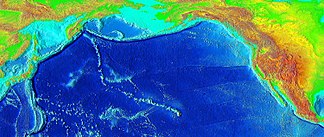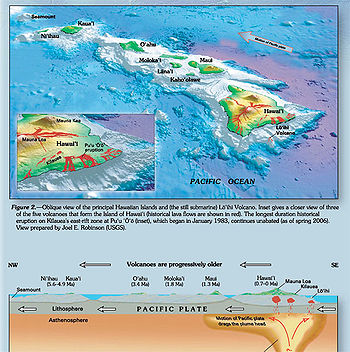Hawaii Emperor necklace
| Hawaii Emperor necklace | |
|---|---|
|
Hawaii Emperor chain in the middle |
|
| Highest peak | Mauna Kea ( 4205 m ) |
| location | in the Pacific Ocean |
| Coordinates | 32 ° N , 174 ° E |
The Hawaii-Emperor-Chain (in German literature sometimes also referred to as the Hawaii-Imperator-Back ) is a chain of mostly extinct shield volcanoes in the Pacific Ocean , a large part of which lies below the sea surface. It consists of over 129 larger volcanic structures, which are strung together like a string of pearls over a length of 6100 km and are up to 89 million years old. The chain is usually cited as a prime example of so-called hotspot volcanism.
Geographical location
The 2800 km long northern Emperor chain, which runs from north to south, makes a bend and merges into the Hawaiian island chain, which runs south-east and is also arranged like a string of pearls. This is sometimes called the Hawaii back. The chain of volcanoes thus extends from the Aleutian Trench in the north, where the Pacific Plate dips under the North American Plate , to Hawaii .
Emergence
The arrangement and the increasing age of the seamounts of the Hawaii-Emperor chain was explained for the first time by John Tuzo Wilson with a movement of the Pacific tectonic plate over a fixed hotspot that was presumed at the time for more than 80 million years . Seismic data available today show anomalies down to the lower mantle (at least 1200 km depth). This anomaly could be caused by subducted oceanic crust from 650 to 200 million years ago.
Due to the continental plate drift , active volcanism shifts at a rate of 8 to 10 cm per year.
Kink controversy
The kink, which is said to indicate a change in the movement of the Pacific plate around 43 million years ago, is according to one theory the result of the collision of the Indian subcontinent with the Eurasian plate . The speed of India would have decreased to the north, the subcontinent would have rotated counterclockwise and so there would have been a change in the movement of the Pacific continental plate.
For several years there has been some scientific evidence for the thesis that hot spots are deflected by the convection movements in the earth's mantle and therefore cannot be regarded as stationary in relation to the movements of plate tectonics. According to this, the hot spot would have migrated southwards at a speed of 4 cm per year from 81 to 47 million years ago and would then have slowed down its movement considerably. The collision of the Indian subcontinent with the Eurasian plate would at least not be a direct cause of the kink. Investigations on the Musicians seamounts north of the Hawaiian Archipelago, however, provided evidence that the kink was at least partially due to an acceleration of the northwest-directed movement of the Pacific plate after the complete subduction of the Izanagi plate under East Asia and the beginning of the subduction of the Pacific plate on the western edges of the Pacific Basin around 50 million years ago.
The mountains below the surface of the sea
The northernmost submarine volcano is the Meiji Seamount , at about 53 ° north latitude and 165 ° west longitude. It is a plateau about 2000 m above the sea floor, about 85 million years old. This joins south of the Detroit Rise Seamount, with an age of about 81 million years.
Many of these submarine volcanoes were named after a Tennō (Japanese emperor, Kammu , Kimmei , Kōkō , Meiji , Nintoku , Ōjin , Suiko , Yōmei , Yūryaku ) or people associated with them ( Jingū ).
The islands of the Kure Atoll and about 80 km further east the Midway Islands , at latitude 28 ° north and longitude 177 ° west, are the first islands of the Northwestern Hawaiian Islands . These are volcanoes that reach up to the surface of the water or even pierce them. The Kure Island (main island of the Kure Atoll) is therefore the oldest island in the Hawaii-Emperor chain with an age of about 30 million years. The next younger islands are the Midway Islands with an age of about 28 million years. Originally, the Midway Islands were a large shield volcano that reached up to or above the surface of the water. Over time the volcano was slowly eroded, so that today only two small main islands and several small islands, as well as a 160 m high atoll with a diameter of 6 km can be seen today.
The youngest volcano Lōʻihi is 35 km southeast of the island of Hawaii . The largest volcano in the Hawaii-Emperor chain is Mauna Kea , which is about 10,205 m high from the foot under water to the summit. Above water it reaches a height of 4205 m.
List of various seamounts
- Jingu Guyot
- Kammu Guyot
- Kimmei Seamount
- Koko Guyot
- Meiji Seamount
- Nintoku Guyot
- Ojin Guyot
- Suiko Guyot
- Yomei Guyot
- Yuryaku Guyot
Web links
- John A. Tarduno, Robert A. Duncan: Motion of the Hawaiian Hotspot: a Paleomagnetic Test
- Ken Rubin: The Formation of the Hawaiian Islands , Hawaii Center for Volcanology, University of Hawaii, Manoa
- Deep recycling in the Earth faster than thought PhysOrg, August 10, 2011
- Oceanic islands preferred thin crust PhysOrg, September 17, 2012
- Hotspots or not? Isotopes score one for traditional theory PhysOrg, December 6, 2006
- Albrecht W. Hofmann, Alexander Sobolev, Wafa Abouchami, Stephen J. Galer, Anatomy of a mantle plume . In: Activity report 2005 , Max Planck Institute for Chemistry , accessed on June 10, 2017 (PDF file).
Individual evidence
- ↑ a b Hans-Ulrich Schmincke : Vulkanismus. 2nd, revised and expanded edition. Wissenschaftliche Buchgesellschaft, Darmstadt 2000, ISBN 3-534-14102-4 , p. 82.
- ↑ Cecily J. Wolfe, Sean C. Solomon, Gabi Laske, John A. Collins, Robert S. Detrick, John A. Orcutt, David Bercovici, Erik H. Hauri: Mantle shear-wave velocity structure beneath the Hawaiian hot spot. In: Science. Vol. 326, No. 5958, 2009, pp. 1388-1390, doi: 10.1126 / science.1180165 , (alternative full-text access : Yale University ).
- ↑ Cecily J. Wolfe, Sean C. Solomon, Gabi Laske, John A. Collins, Robert S. Detrick, John A. Orcutt, David Bercovici, Erik H. Hauri: Mantle P-wave velocity structure beneath the Hawaiian hotspot. In: Earth and Planetary Science Letters. Vol. 303, No. 3–4, 2011, pp. 267–280, doi: 10.1016 / j.epsl.2011.01.004 , (alternative full text access : HIGP ( memento of October 24, 2011 in the Internet Archive )).
- ↑ Alexander V. Sobolev, Albrecht W. Hofmann, Klaus Peter Jochum, Dmitry V. Kuzmin, Brigitte Stoll: A young source for the Hawaiian plume. In: Nature. Vol. 476, No. 7361, 2011, pp. 434-437, doi: 10.1038 / nature10321 .
- ↑ John Tarduno, Hans-Peter Bunge, Norm Sleep, Ulrich Hansen: The Bent Hawaiian-Emperor hotspot track: Inheriting the Mantle wind. In: Science. Vol. 324, No. 5923, 2009, pp. 50-53, doi : 10.1126 / science.1161256 .
- ↑ John M. O'Connor, Kaj Hoernle, R. Dietmar Müller, Jason P. Morgan, Nathaniel P. Butterworth, Folkmar Hauff, David T. Sandwell, Wilfried Jokat, Jan R.Wijbrans, Peter Stoffers: Deformation-related volcanism in the Pacific Ocean linked to the Hawaiian-Emperor bend. In: Nature Geoscience. Vol. 8, No. 5, 2015, pp. 393–397, doi : 10.1038 / NGEO2416 (alternative full text access : ResearchGate ).
- ^ Hawaiian Volcano Observatory, Loihi Volcano
- ↑ Hawaiian Volcano Observatory, Mauna Kea Volcano

